Janice Horton's Blog, page 11
November 21, 2023
Japan: Tokyo Tower
Visiting Tokyo Tower: Tokyo Tower was celebrating its 65th anniversary during our Japan trip this year.
If you’ve seen my posts and photos from Kuala Lumpur’s Petronas Towers or Taipei 101 or the Bitexco Tower in Ho Chi Minh City, and so many others, then you’ll know I absolutely love a city tower.
The Tokyo Tower is no exception, and I was really looking forward to gazing over the cityscape of the world’s largest city, from the perspective of the highest viewpoint possible.
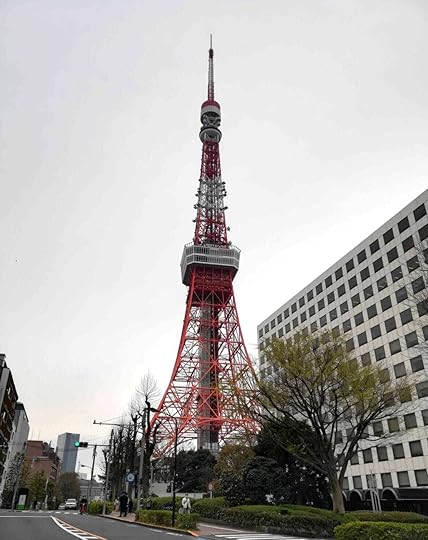
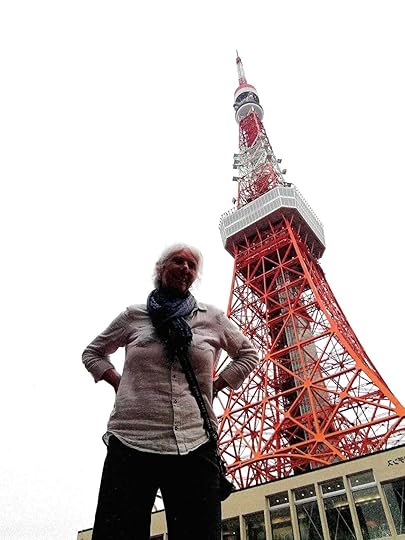
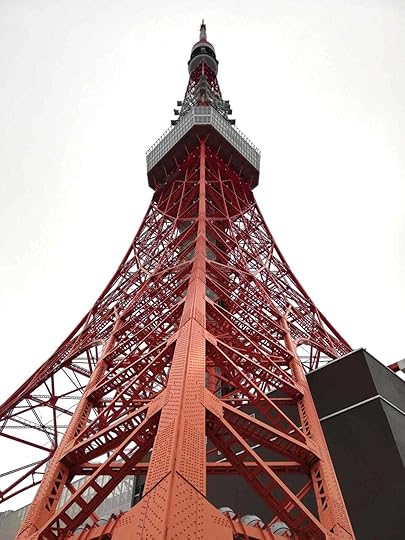 CAN YOU SEE MOUNT FUJI FROM THE TOKYO TOWER
CAN YOU SEE MOUNT FUJI FROM THE TOKYO TOWER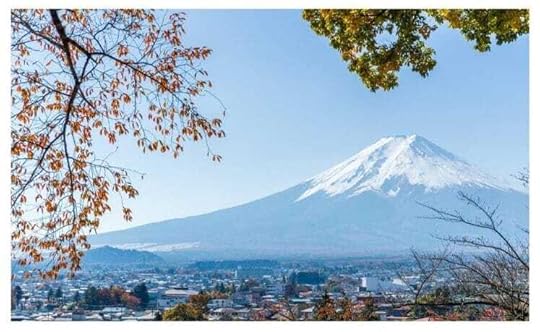
We were in Tokyo at the end of March this year for the blossom season, and I was also hoping for a view of a snow-capped Mount Fuji. It is said that on a clear day there are great views of the mountain from the observation decks in Tokyo Tower.
So we booked our tickets for the tower in the morning – when you have a higher chance of seeing Mount Fuji – from either the main deck at 150 metres high or the top deck at 250 metres high.
I booked tickets and received a QR Code for the Top Deck Tour online and directly with the (not an affiliate link) Tokyo Tower website.
You can likely buy your tickets for the Main Deck at the tower but you should book your Top Deck Tour tickets in advance and online as numbers to the higher deck are restricted and by reserved time slots only.
The main elevator takes you to the main deck, which is a carpeted area with several glass panels in the floor and a 360-degree view of the city below.
There is also a café and a shop.

MAIN OBSERVATION DECK
The main deck was quite crowded when we were there and, although I enjoyed looked out across the city skyscrapers, it was a much cloudier day than the day previously when we’d arrived in Tokyo from Hiroshima, and so I couldn’t see Mount Fuji as a backdrop to the dramatic Tokyo cityscape. Perhaps I’d have more luck from the Top Deck?!
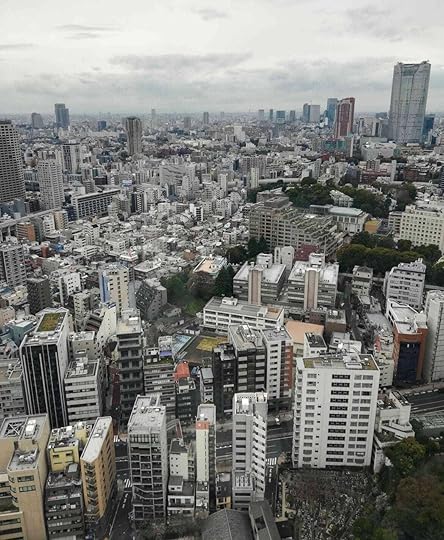
 THE TOP DECK TOUR
THE TOP DECK TOURIf you are taking the Top Deck Tour then, at your allotted time and using your QR code, you take the separate glass elevator up from the main deck.
Taking the second glass elevator to the top deck does feel like a VIP experience.
The Top Deck Tour is advertised as providing a ‘floating in the sky experience’.
Guests are provided with a multi-lingual voice guide system, a short history of the tower presentation by a tour guide prior to boarding the glass elevator and a complementary photo gift card and a hospitality drink.
I thought the Top Deck Tour was worth the extra ticket price.
I loved the whole experience and hope you enjoy my photos!
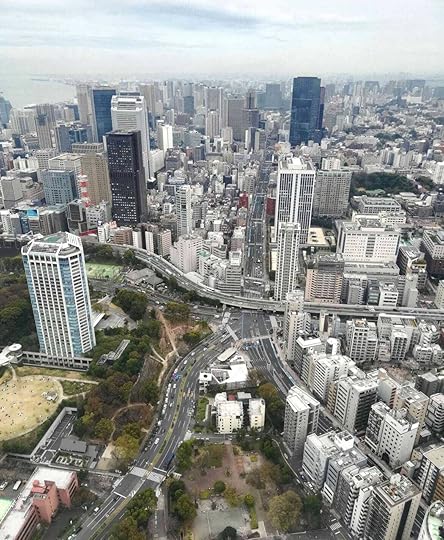
 TOKYO TOWER VIEW
TOKYO TOWER VIEWInside the Tokyo Tower, the top deck is a labyrinth of geometric mirrors and LED lighting as well as providing a 20 metre high and 360 degree wide view over the city.
Although, sadly, Mount Fuji did not make an appearance that day.
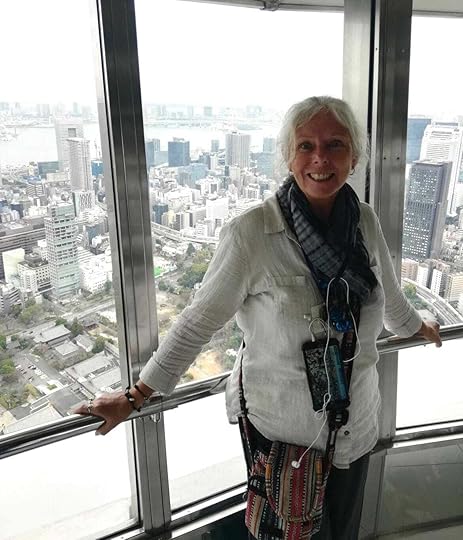
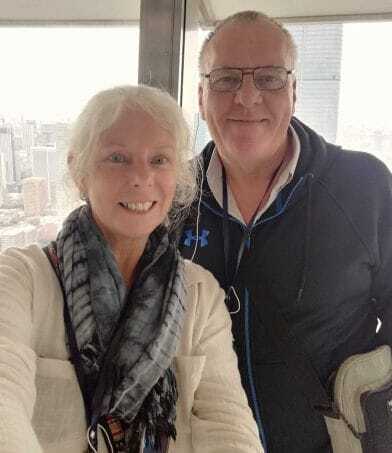 TOKYO TOWER HISTORY
TOKYO TOWER HISTORYTokyo Tower was originally built as a national broadcast tower in 1958.
When it was build, at 333 metres tall, (that’s 1029 feet) it was the tallest freestanding tower in the world.
The tower was the tallest structure in the whole of Japan before the Skytree was constructed in 2010.
WHY DOES THE TOKYO TOWER LOOK LIKE THE EIFFEL TOWERThe designer, Tachu Naito, took is inspiration from the West and he based his design on the Eiffel Tower in Paris.
But – of course – he made his tower 13 metres taller to make it the (then) tallest freestanding tower in the world.
5 TOKYO TOWER FACTS1. If you prefer not to take the elevators, you can take the 600 steps instead.
2. During the cherry blossom season in spring, Tokyo Tower is often illuminated with special lighting to celebrate the beauty of the cherry blossoms.
3. The tower looks to be painted in red and white but it is actually orange and white and the colour cannot be changed as it is decided on by the law to suit international air safety regulations. It gets repainted every five years.
4. The tower is considered a symbol of Tokyo and it is also an iconic landmark of Japan.
5. Around midnight, courting couples like to gaze up at the tower because of the romantic legend (connection to Paris France?) that if you see the moment the lights turn off with your lover, then you will always be happy together.

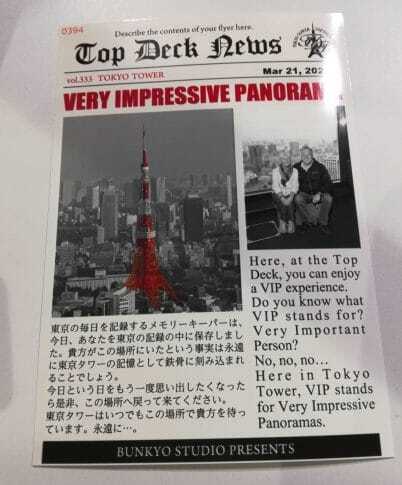 HOW TO GET TO TOKYO TOWER
HOW TO GET TO TOKYO TOWERThe Tokyo Tower is in the Minato Ward of the city. The closest subway stations are Onarimon Station on the Mita Subway Line, Akabanebashi Station on the Oedo Subway Line and Kamiyacho on the Hibiya Subway Line.
All about a 5-10 minute walk from the tower.
Alternatively, you can reach the tower in about a 15-20 minute walk from Hamamatsucho Station on the JR Yamanote Line or Daimon Station on the Asakusa or Oedo subway lines. You can use your Suica Card on the subways or JR Pass on the trains.
In Tokyo we stayed at a hotel called HOTEL MONTEREY AKASAKA which was wonderful and in a great location for sightseeing. This hotel is in Akasaka district and just 1500 feet from the metro station. We booked using (affiliate link) Booking Dotcom.
Are you planning a trip to Japan?
Click here to find out more about our Grand Japan Adventure!
Is Tokyo on your Itinerary?
Let me know? Leave a comment.
I’d be delighted to hear from you!

THE BACKPACKING HOUSEWIFE RECOMMENDS BOOKING DOTCOM
THE BACKPACKING HOUSEWIFE RECOMMENDS TRAVEL INSURANCE
The post Japan: Tokyo Tower appeared first on The Backpacking Housewife.
November 19, 2023
Japan: Exploring Miyajima
Miyajima is an island in the Seto Inland Sea in Hiroshima Bay, Japan. It is also known as Itsukushima Island, which means ‘shrine island’.
When planning our two-week and four-city itinerary for our Japan adventure this year – starting in Fukuoka and taking the famous shinkansen bullet train to Hiroshima then onto to Tokyo and Osaka – taking a day out to explore Miyajima Island from Hiroshima was a highly anticipated top priority for us.
I was excited to visit Miyajima Island for these seven fabulous reasons.
SEVEN REASONS TO GO EXPLORING MIYAJIMA1. MOUNT MISEN: Firstly, Miyajima has beautiful natural forests and its highest point – Mount Misen – has ‘ropeway’ of cable cars and hiking trails and from the observation deck at the top there are incredible panoramic views.
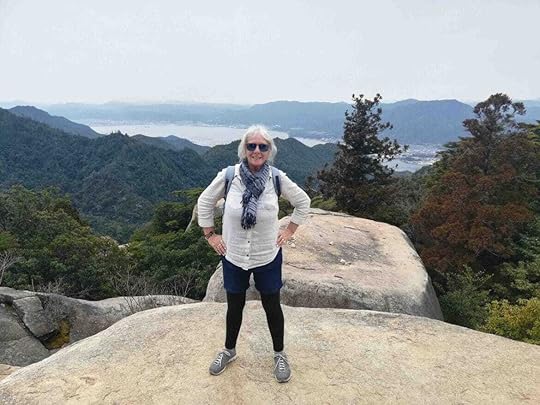
2. THE SHRINE OF THE ETERNAL FLAME: Also at the top of Mount Misen there are many shrines including The Shrine of The Eternal Flame or Keizu-no-Reikado. This ‘holy fire’ has been keeping a huge pot of tea warm for the past 1200 years!
Our quest to drink from this 1200 year old pot of tea was a grand highlight of our day on Miyajima Island.
You can watch a short video below or read more about this adventure in my post A 1200 Year Old Pot Of Tea.
The Eternal Flame on Miyajima was used as the source to light the Flame of Peace that is burning in Hiroshima’s Peace Memorial Park.
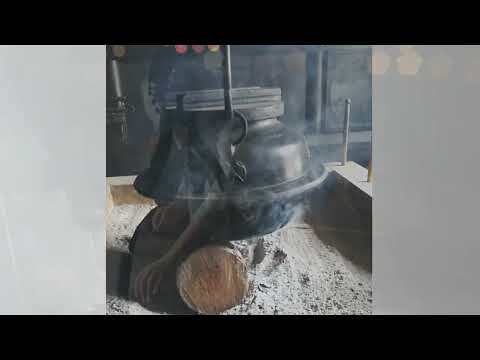
3. UNESCO WORLD HERITAGE: Miyajima also has the UNESCO World Heritage Site of Shinto Shrine of Itsukushima.
Originally built in 593 over the water and dedicated to three female deities – Ichikishima-hime-no-mikoto, Tagori-hime-no-mikoto and Tagitsu-hime-no-mikoto – as gods of the sea, transport, and fortune.

4. THE TORII GATE: The Floating Torii Gate of Miyajima is one of the most photographed scenes of Japan. It is also part of the Itsukushima Shrine UNESCO site. It is located 200 meters offshore and appears to float on the water when the tide is in.
When the tide is out, the Torii gate is accessible from the beach. When the sea is calm, it’s possible to experience passing through the Torii gate on a boat. The custom is to bow twice, clap twice, and bow again to receive a blessing.
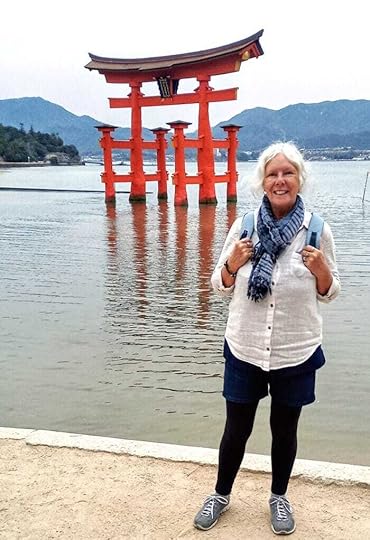
5. FIVE STORY PAGODA: There is a beautiful 14th Century five-story pagoda ‘Gojunoto’ on Miyajima that provides a picturesque backdrop to the island’s stunning scenery. Each tier represents the five elements of air, water, earth, fire, and void.
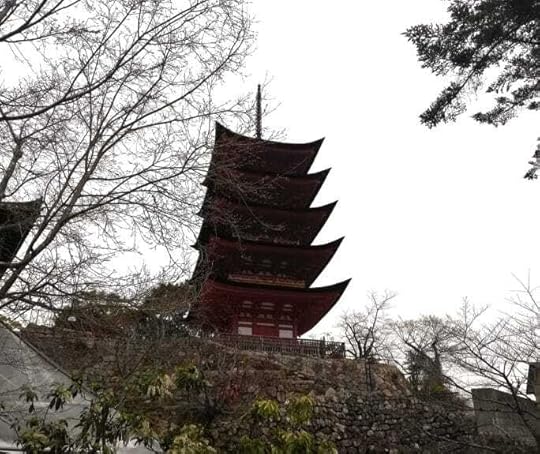
6. THE DEER: For the past 800 years, Mjyajima has had over 500 scared wild ‘Sika’ deer wandering around the island. They are considered to be messengers of the gods and protected by law. There are signs to tell you not to feed the wild deer, but of course the deer can’t read, and they can be quite assertive. They are also very cute and don’t mind people petting them.
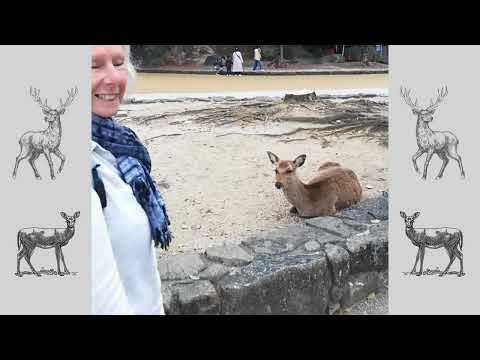
7: FOOD: Miyajima also offers amazing food and is particularly known for its extra-large plump and delicious oysters cultivated in the bay. I had to try them grilled and in a curry bread roll and in my okonomi-yaki. If you love seafood – especially oysters – and you want to experience fresh and authentic Japanese food then my Miyajima Food Guide post is not to be missed!
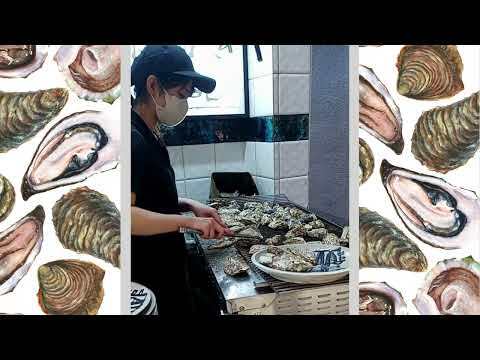
HOW TO GET TO MIYAJIMA FROM HIROSHIMA
It’s easy to get to Miyajima Island by tram or train and then ferry from the city of Hiroshima.
For this reason we went to Miyajima Island on a day trip from Hiroshima that we organised ourselves.
We used a combination of tram (or local train from San-Yo Line) and a 10-minute ferry ride.
We were staying in JHoppers Guest House in Hiroshima, so we didn’t stay on Miyajima Island overnight.
But if you’re planning a night or two on Miyajima, I recommend using (affiliate) Booking Dotcom.
We used our Suica Card to ride the tram (Line 2) from Hiroshima Station to Miyajima-guchi Station.
When you arrive at Miyajima-Guchi Station, walk for 5-6 minutes to the ferry terminal for the ferry ride.
The route is well signed and you can generally just follow the crowd.
Buy your ticket and take the next ferry boat over to Miyajima Island.
The ferry boats run frequently – three or four times an hour – and journey time is around 10 minutes. Easy!

THE BACKPACKING HOUSEWIFE RECOMMENDS BOOKING DOTCOM
THE BACKPACKING HOUSEWIFE RECOMMENDS TRAVEL INSURANCE
The post Japan: Exploring Miyajima appeared first on The Backpacking Housewife.
November 17, 2023
Miyajima Food Guide
If you love seafood – especially oysters – and you want fresh and authentic Japanese food then my Miyajima food guide is not to be missed.
Miyajima island is well worth a visit for so many reasons as it offers a UNESCO World Heritage site with the Itsukushima Shrine and its world-famous icon the Floating Torii Gate and, of course, the Seven Wonders of Mount Misen and the Shrine of the Eternal Flame and its 1200 year old pot of tea. There’s so much on Miyajima lsland to explore!
But who knew that the food scene – including street food – is so incredible here?!
After hiking up Mount Misen, we returned hungry to Omotesando Street on Miyajima, and I was excited to try the grilled oysters and oyster curry bread and oysters baked in lemon sponge dough balls and the famous Miyajima Okomoni-Yaki!
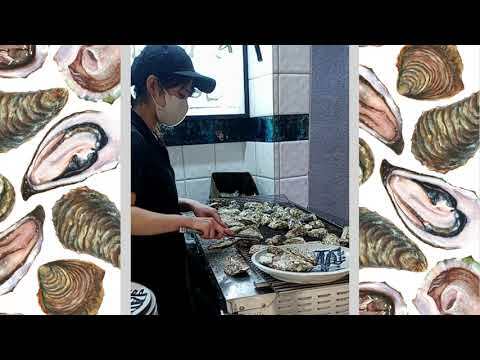
WHAT TYPE OF FOOD IS MIYAJIMA FAMOUS FOR?
Fresh Oysters: Miyajima has access to the freshest premium-size oysters grown for three years as opposed to one year in the plankton-rich and shallow waters of Hiroshima Bay. They are huge and plump and fragrant and delicious.
Oyster Curry Bread: I love curry and these crunchy dough balls contained two whole large oysters. The flavour was of a mild curried beef oyster. Delicious!
Moniji Manju: Freshly baked or fried momiji manju is a lemon-flavored sponge cake dough often shaped like a maple leaf. It can be topped with ingredients of your choice. I chose marinated oysters (rather than the other local delicacy of conga eel) and the sweet and salty flavour was so tasty!
Okomoni-Yaki: Then after wandering around snacking and browsing the interesting shops on the street, we found ourselves drawn by the amazing aromas into a Okonomi-Yaki restaurant called Kurawanker.
Okonomi-yaki is a Japanese dish cooked and served on a griddle.
‘Okonomi’ means ‘what you like’ and ‘yaki’ means ‘grilled’.
So, the food is cooked to your liking with layers of pancake and a mixture of cabbage, egg, bean sprout, noodles, egg, and whatever you order with it. I chose oysters and my backpacking husband chose scallops with his Okonomiyaki.
In Kurawanker restaurant, the griddle is the length of the room and the food is cooked in front of you as you sit at the h is 6m long and 18mm thick. The delicious smells of the Okonomiyaki and the sauce fill the restaurant.
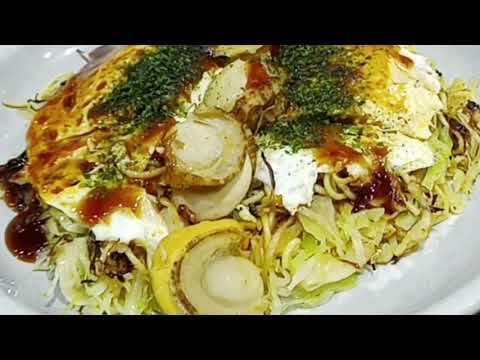
FOOD TO TRY IN MIYAJIMA
I made a Miyajima food map video of our meal being cooked to show you how fascinating it was to watch the Okonomiyaki being prepared and how the layers of ingredients were assembled on the ‘production line’ at the griddle.
It was amazing and the food was absolutely delicious!
Of course, this post only covers the food that we tried on Miyajima Island, and doesn’t even cover the half of the amazing local dishes that are on offer to you.
Our gastronomic experience in Japan so far has been exciting.
We’ve now enjoyed fantastic local Japanese food in Fukuoka and then Hiroshima and now in Miyajima.
Next stop Tokyo!
 HOW TO GET TO MIYAJIMA FROM HIROSHIMA
HOW TO GET TO MIYAJIMA FROM HIROSHIMAWe went to Miyajima Island on a day trip from Hiroshima that we organised ourselves using a combination of tram (or local train from San-Yo Line) and a 10-minute ferry ride.
We used our Suica Card to ride the tram (Line 2) from Hiroshima Station to Miyajima-guchi Station.
When you arrive at Miyajima-Guchi Station, walk for 5-6 minutes to the ferry terminal for the ferry ride.
The route is well signed and you can generally just follow the crowd.
Buy your ticket and take the next ferry boat over to Miyajima Island.
The ferry boats run frequently – three or four times an hour – and journey time is around 10 minutes. Easy!
Are you planning a trip to Japan?
Is Hiroshima on your Itinerary?
Will you visit Miyajima Island?
Let me know? Leave a comment.
I’d be delighted to hear from you!
THE BACKPACKING HOUSEWIFE RECOMMENDS BOOKING DOTCOM
THE BACKPACKING HOUSEWIFE RECOMMENDS TRAVEL INSURANCE
The post Miyajima Food Guide appeared first on The Backpacking Housewife.
November 16, 2023
Miyajima: A 1200 Year Old Pot of Tea
A 1200 Year Old Pot of Tea: Miyajima means ‘shrine island’ because it literally has so many Buddhist and Shinto sacred shrines. The island was formerly known as Itsukushima – as in the name of its most famous shrine (593AD) now a UNESCO World Heritage site.
I was excited to visit Miyajima during our Japan trip on a day trip from Hiroshima because Miyajima is famous for so many amazing things – perhaps more than any other island in Japan – and all those amazing things I will cover in a separate post Exploring Miyajima Island.
But the one thing that fascinates me most about Miyajima – and that is the subject of this post – is the shrine on the top of the mountain called Keizu-no-Reikado containing the Holy Fire known as The Eternal Flame.
A fire that has been burning continuously for 1200 years.
And, hanging above this fire, is a giant pot of tea.
Yes, really! A 1200-year-old pot of tea!
OUR QUEST: A 1200-YEAR-OLD POT OF TEAOur quest to find the Shrine of the Eternal Flame and to drink from a 1200 year old pot of tea awaited us if we could only get to the top of Mountain Misen on Miyajima Island!
I wondered what the tea might taste like after all that time?
Of course, the water in the pot is regularly topped up and the flame is kept going by a Guardian Monk.
But it’s hard to imagine the fire has never been allowed to go out… even accidentally.
Imagine the responsibility!?
The fire was first lit in the year 806 by a great Buddhist priest. His name was Kobo Daishi born 27th July in the year 774. He died on 22nd April 835 (Japanese calendar). He was known as a great teacher, the father of Japanese culture, a Grand Master, and the founder of the most popular Shingon Sect ‘True Word’ of Buddhism.
GETTING TO THE REIKADO SHRINE AND ETERNAL FLAME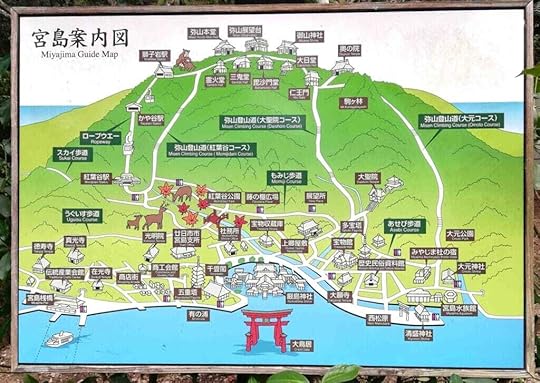 A choice of routes to the top of Mount Misen
A choice of routes to the top of Mount MisenTo get to the Reikado shrine and the Eternal Flame and the 1200-year-old pot of tea – which resides at the top of the mountain and at 535 meters above sea level – one first has to walk from the ferry point after arriving on Miyajima, through the small town.
We had to reluctantly ignore the street sellers cooking oysters and other tempting bites along the main street – as we had packed a picnic lunch – but I promised to try the local food upon our return from the mountain.
We marched on past the sacred Itsukushima Shrine and the beautiful famous floating Torii Gate – the symbol of Miyajima Island. More on all of these wonders in my post Exploring Miyajima Island.
Then walk past the amazing five-story Pagoda Shrine (dating from 1407) and the Daisho-In-Temple and into Momijidani Park that is styled like a beautiful Japanese Garden with wooden bridges and water features and stone statues.
Then, we followed the wandering sacred Miyajima deer and the signs into the Komaga Forest. And, from the forest you have a choice of route.
You can take one of the several hiking trails and routes of various levels of difficulty – or take what is called The Ropeway – which is a cable car.
Two cable cars, actually.

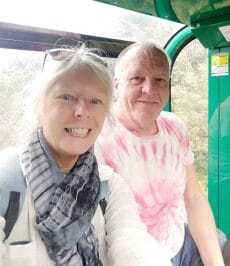
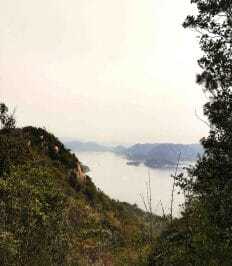
The first one takes you from Momijidani Park up to Kayatani Station at 371 meters above sea level. From which you take a second cable car across to Shishiwa Station at 433 meters above sea level. Then it’s a walk.
If you’ve watched my video you’ll see it’s quite the trek and a rather a rough hike along rugged pathways and 2000 steps for that last 100 meters to the top of the mountain. But it’s worth it for the views alone.
The views from Mount Misen offer panoramic views over the Seto Inland Sea.

THE REIKADO SHRINE AND ETERNAL FLAME
But, of course, what was keeping me going was the thought of that 1200-year-old cup of tea, the Eternal Flame, and seeing the ancient shrine for myself.

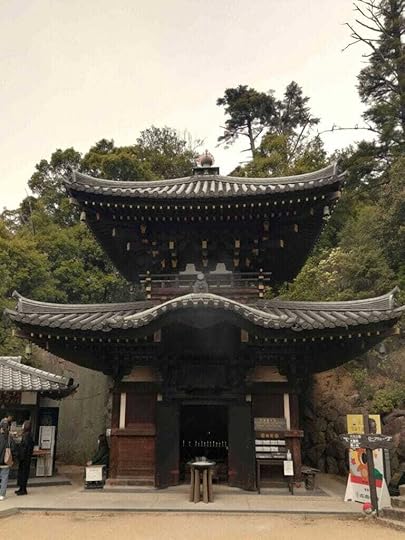
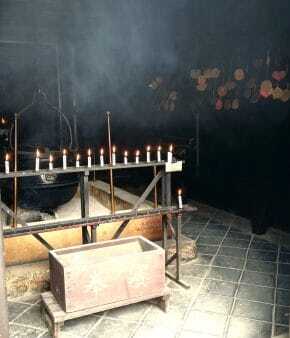
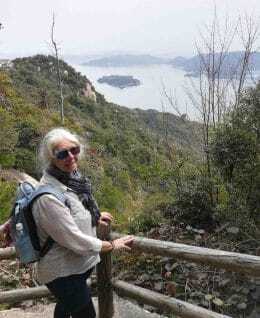

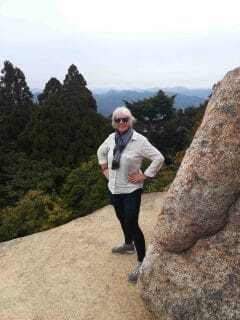
There are actually many shrines and temples to see along the way.
Then the final push up past smooth giant boulders and a stone staircase to the 1200-year-old pot of tea!
The sacred Reikado Shrine is a small wooden building with a tiled double roof that is easy to find because it sits surrounded by woodsmoke on the plateau. The shrine is also known as ‘Lover’s Sanctuary’ as this miraculous fire is considered to represent the eternal fire of love.
We removed our shoes and went inside the sacred smoky aura to see the fire bellowing and suspended above it was a huge black cast iron cauldron. The 1200-year-old pot of tea!

A 1200 YEAR OLD POT OF TEA!
With eyes stinging and lungs burning in the smoky room, I approached the pot and wrestled with the heavy wooden lid, and with a ladle scooped out two measures of the tea in into the small paper cups provided.
I sipped and tasted and considered the flavour. It was green jasmine tea, I decided. And it was delicious.
The tea is said to have magical, medicinal and therapeutic properties.
THE SEVEN WONDERS OF MOUNT MISEN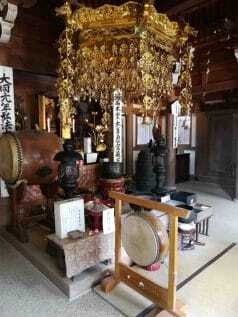
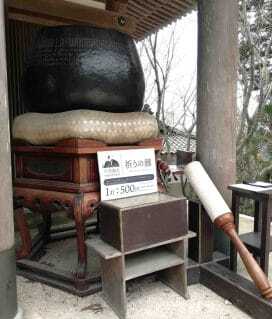
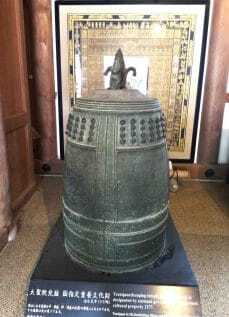
The Eternal Flames is just one of Seven Wonders of Mount Misen. The flame was also used the source to light the Flame of Peace in Hiroshima Memorial Peace Park and is just one of the many amazing experiences to greet the visitor to Miyajima Island.
I hope you enjoyed reading this post as much as I enjoyed this adventure and our quest to find The Eternal Flame and the 1200-year-old cup of tea!
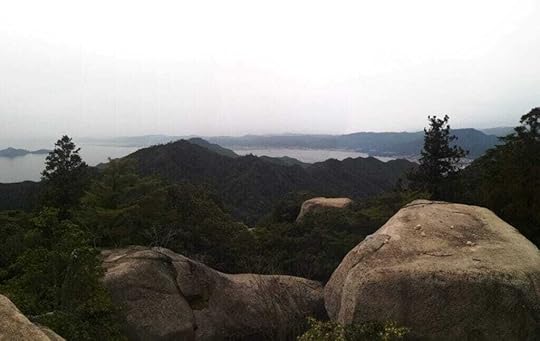


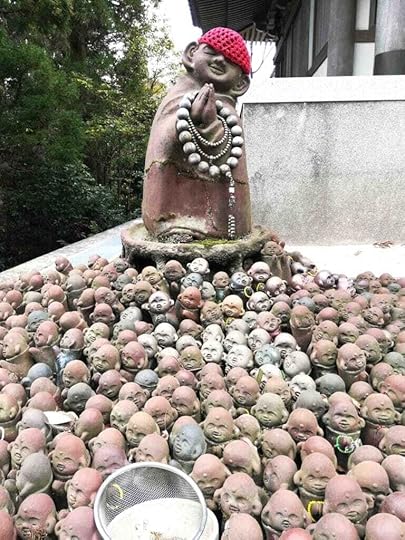 HOW TO GET TO MIYAJIMA FROM HIROSHIMA
HOW TO GET TO MIYAJIMA FROM HIROSHIMAWe went to Miyajima Island on a day trip from Hiroshima that we organised ourselves using a combination of tram (or local train from San-Yo Line)) and a 10-minute ferry ride.
We used our Suica Card to ride the tram (Line 2) all the way from Hiroshima Station to Miyajimaguchi Station.
When you arrive at Miyajima-Guchi Station, walk for 5-6 minutes to the ferry terminal for the ferry ride. The route is well signed and you can generally just follow the crowd.
Buy your ticket and take the next ferry boat over to Miyajima Island.
The ferry boats run frequently – three or four times an hour – and journey time is around 10 minutes. Easy!
Are you planning a trip to Japan?
Is Hiroshima on your Itinerary?
Will you visit Miyajima Island?
Let me know? Leave a comment.
I’d be delighted to hear from you!
THE BACKPACKING HOUSEWIFE RECOMMENDS TRAVEL INSURANCE
THE BACKPACKING HOUSEWIFE RECOMMENDS BOOKING DOTCOM
The post Miyajima: A 1200 Year Old Pot of Tea appeared first on The Backpacking Housewife.
November 14, 2023
Shukkeien Garden Hiroshima
As part of our Japan trip and Hiroshima itinerary, I was really looking forward to experiencing the pleasure of a stroll through the traditional Shukkeien Japanese Garden.
Just a few days earlier, I had experienced the Nanzoin Temple Japanese Gardens in Fukuoka and was feeling quite smitten with the spiritual combination of elements in stone, water, plants, and fish, required to create an authentic and traditional Japanese garden design.
The Shukkeien Garden has all this too and despite its location in the centre of Hiroshima City and only being 2km from the Hiroshima Peace Memorial Park.
We walked to visit the garden as our accomodation was close to the Peace Park and it took us just under 30 minutes. I’ve shown opening hours and other ways to get to the garden at the end of this post.
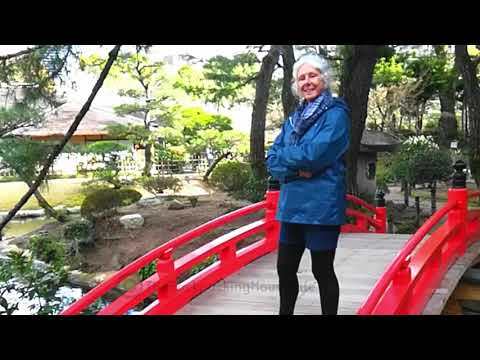
WHERE TO STAY IN HIROSHIMA
We used Booking Dotcom (affiliate link) to find and to book our various accommodations while in Japan and we very happy staying three nights at J-Hoppers Hiroshima Guesthouse at a total cost of 17,000 Yen. That’s less than 100 GBP.
The guesthouse was wonderful and I made a video of it at the end of this post about the Peace Memorial Park to show you that it’s sometimes a good choice to stay in a budget accomodation in order to allow for more expensive cities like, for example, Tokyo.
SAKURA SEASON IN THE GARDENThe word Shukkeien means “shrunken-scenery garden” which is a perfect description of the miniature representations of valleys, mountains and forests in this garden’s intricate and carefully planned design.
During our visit, at the end of March this year, it was the start of the ‘Sakura’ or cherry blossom season.
Enjoying the early blossoms or ‘hanami’ – as cherry blossom watching is called in Japan – certainly made our visit to Shukkeien Garden extra special along with meeting a lovely Japanese lady wearing her kimono.

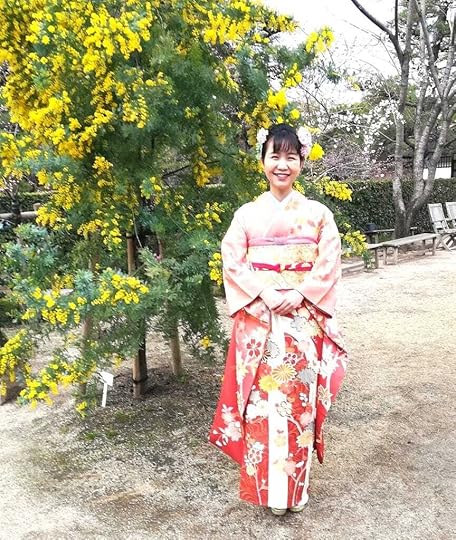
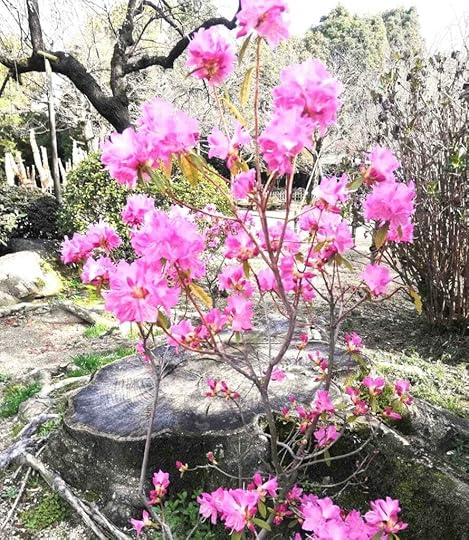
We followed the winding and connecting paths and bridges and paused often to admire the many traditional Japanese garden features, tea houses, arbours and ornate bridges and to feed the carp swimming in the pond with the fish food that we’d been able to buy at the ticket gate.
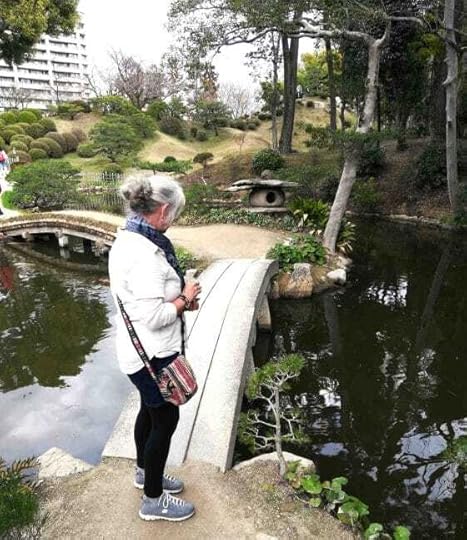
The central pond with its fourteen islands of various sizes is cleverly designed to represent the fourteen islands in the nearby Inland Sea.

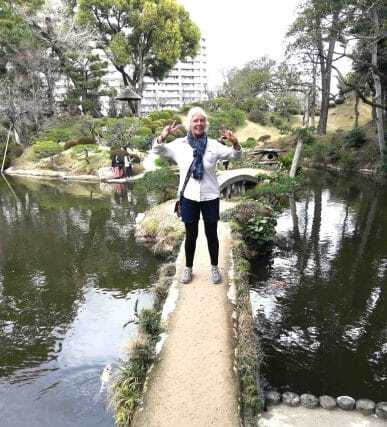
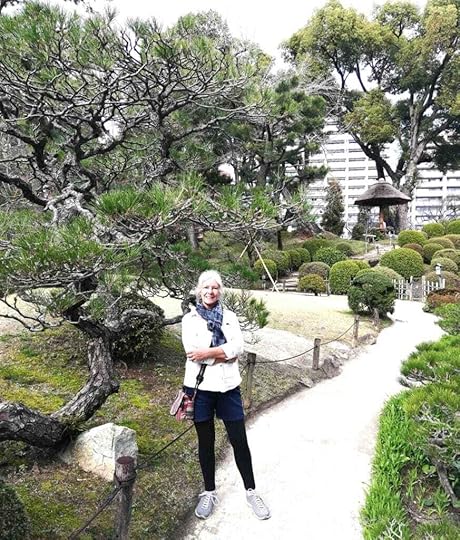
 SHUKKEIEN GARDEN HIROSHIMA HISTORY
SHUKKEIEN GARDEN HIROSHIMA HISTORY
Shukkeien Garden has a long history dating back to 1620 when it was designed by Soko Ueda for his Lord Asano of Hiroshima.
The garden, lovingly referred to as ‘Sentai’ by the people of Hiroshima before the war, was completely destroyed as a result of the atomic bombing in 1945.
Many survivors desperate to find water took refuge here immediately following the bombing but died before receiving medical care. Their remains were interred withing the garden.
Only three trees in the garden are said to have survived the bombing including an old gingko tree that people now like to touch in order to connect with the tree’s enduring spirit.
A memorial was placed amongst the trees for those who died and were buried here when the garden was restored in 1949 and then opened in 1951.
 SHUKKEIEN GARDEN TO HIROSHIMA CASTLE
SHUKKEIEN GARDEN TO HIROSHIMA CASTLE
We coincided our visit to Shukkeien Garden with our trip to Hiroshima Castle as it is right next door and just a short walk away.
If you are wondering how long does it take to see the Shukkeien Garden then would allow an hour or two for your visit to each of these sites – the shrunken scenery garden and the adjacent castle – to also fully appreciate the parks and gardens.
Shukkeien Garden Opening Hours: 9:00 to 18:00 (until 17:00 from September 16 to March 15)
Admission ends 30 minutes before closing.
Shukkeien Garden Entrance Fee: Currently 260 yen
 HOW DO I GET TO SHUKKEIEN GARDEN
HOW DO I GET TO SHUKKEIEN GARDEN
On Foot: Shukkeien is a 15 minute walk from Hiroshima Station.
You can use your Suica Card on public transport in and around Hiroshima.
By Bus: The garden can be reached by the Hiroshima Sightseeing Loop Bus (Meipuru-pu) in about four minutes from Hiroshima Station.
By Tram: The garden is a short walk from “Shukkeien-mae” along tram line 9. From Hiroshima Station, take tram line 1, 2 or 6 to Hacchobori and transfer to tram line 9. The entire journey takes about 15 minutes and currently costs 220 yen.
MORE OF MY PHOTOS OF SHUKKEIEN GARDEN

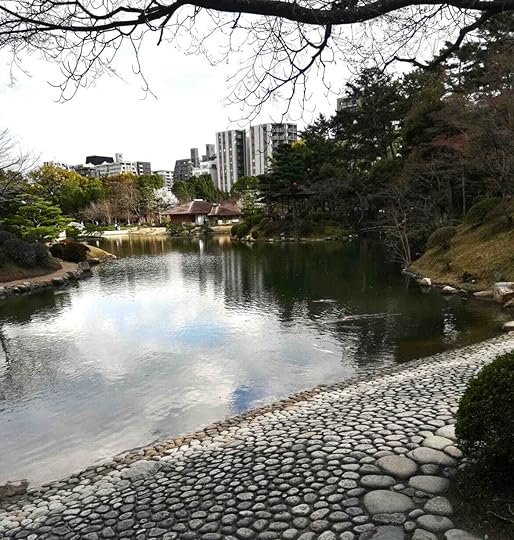
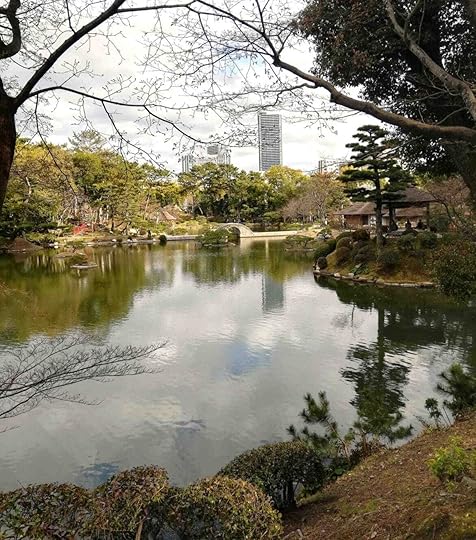
Have you visited Japan?
Are you planning a trip to Japan?
Is Hiroshima on your Japan itinerary?
Let me know! Leave a comment. I’d love to hear from you!
THE BACKPACKING HOUSEWIFE RECOMMENDS BOOKING DOTCOM
THE BACKPACKING HOUSEWIFE RECOMMENDS TRAVEL INSURANCE
The post Shukkeien Garden Hiroshima appeared first on The Backpacking Housewife.
November 13, 2023
Japan: Hiroshima Castle
Hiroshima Castle is really worth visiting and was a highlight of my visit to Hiroshima and Japan.
The castle has a moat and is in a city centre park setting. I was lucky to be there at the end of March this year. The castle looked spectacular as a backdrop to all the cherry blossom trees in the park.
A visit to Hiroshima castle is also a wonderful contrast to the nearby Peace Memorial Park and Peace Museums.
 The Backpacking Housewife at Hiroshima castle
The Backpacking Housewife at Hiroshima castleHiroshima Castle was originally built in 1592 by a powerful feudal lord called Mori Terumoto. He had the castle built in a strategic position where the Ota River once surrounded the castle on three sides.
Today, the castle is located right in the city centre of Hiroshima, surrounded by progressive high-rises and metropolitan buildings, but in a scenic area with a large park and gardens and the Hiroshima Gokoku Shrine nearby.
With its traditional old Japanese castle façade, a three-story keep and a multi-story watchtower, it is a surreal scene in the heart of modern Hiroshima. The castle is just one of many famous landmarks in Hiroshima Japan and is well worth a visit.
 The castle as a backdrop to all the cherry blossom trees in the park.
The castle as a backdrop to all the cherry blossom trees in the park.The Japanese people take ‘Sakura’ the cherry blossom season very seriously, and you’d have to be early or lucky to find and claim a spot in the city park in the vicinity of a cherry blossom tree, to sit and simply admire the blossoms ‘hanami’ or enjoy a ‘bento’ picnic with the family.
The castle is also affectionately known as ‘Rijo’ or ‘Carp Castle’ and – although I saw many large and colourful carp fish swimming in the moat – I’m told that the nickname is actually due to the castle’s carp-shaped roofing facias.
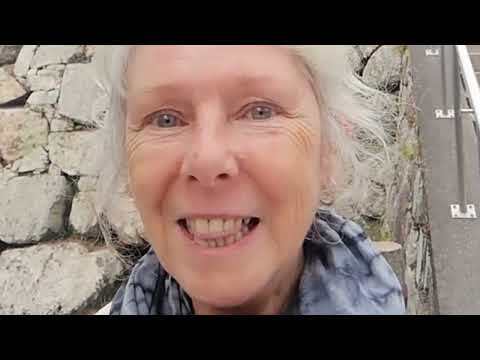
DID HIROSHIMA CASTLE SURVIVE THE BOMB?
The castle we see in Hiroshima today is a faithful representation of the original that was destroyed during the WW2 atomic bombing of Hiroshima on August 6, 1945. The keep was reconstructed in 1958 using concrete and the castle grounds were turned into a public park.
Miraculously, a couple of trees in the castle grounds survived the bombing.
One, a eucalyptus tree, is now 10m tall and 2.75m wide was just 740m from the hypocentre. It’s wonderful to stand next to it and see the tree still thriving today after all it has endured.
 IS HIROSHIMA CASTLE WORTH VISITING?
IS HIROSHIMA CASTLE WORTH VISITING?Hiroshima castle is worth visiting as it was one of the highlights of my visit to Hiroshima. The park is free but there is an entrance fee of 370 Yen to the castle and the tower. It’s worth checking the opening hours and current ticket price on the castle website.
The castle now houses a museum that over several floors in the tower provides information about the history of the castle and the city. I would say to allow two hours for the visit and then take whatever time you need to enjoy the park.
Hiroshima CASTLE HISTORYExhibits inside the castle include art and artefacts related to the castle’s history and Hiroshima’s recovery after the atomic bombing.
There is also a wonderful and authentic Samurai Warrior Exhibition on the third floor at the castle that I found absolutely fascinating.
SAMURAI EXHIBITThe exhibit included displays of items of Samurai culture and swords and weapons and armour and belonging to the former lords of the castle.
It was incredible to see the knives and long swords in glass cases – many without their handles – but still shiny and sharp looking despite being many centuries old. The blades were forged from only the purest steel ‘tamahagane’ or ‘jewel steel’.
There are also suits of armour made from iron and leather plates and dome-shaped iron helmets ‘kabuto’ and scary looking ‘mengu’ facemasks with snarls and fangs and lacquered finishes – also made of leather and iron – designed not only to protect the face but to intimidate enemies in battle.
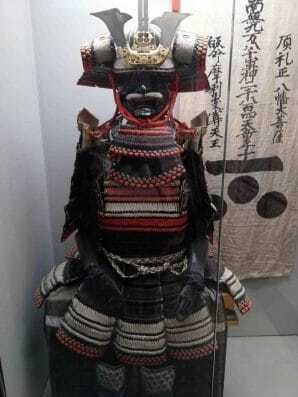

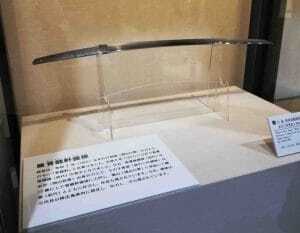
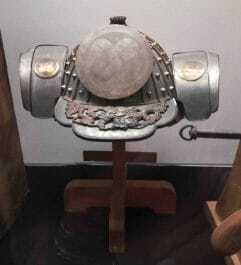 THE OBSERVATION PLATFORM
THE OBSERVATION PLATFORMContinuing on and upwards from the Samurai exhibit on the third floor, on the top floor of the castle and on the ramparts, there is a viewing platform and wonderful panoramic views of the park below and the city of Hiroshima.
From this elevated platform you can see views of the city’s other famous landmarks, such as the Bomb Dome and The Peace Memorial Park and, on clear days, you can apparently see out to Miyajima Island.
Visitors to this castle can explore both the historical aspects of the castle and its significance in the context of Hiroshima’s recovery after the devastation of World War II.
The reconstructed castle serves as a symbol of resilience and the city’s commitment to peace. The park and the gardens are a wonderful place to enjoy a walk and especially so during the cherry blossom season.
 The view of Hiroshima City from the observation platform.HOW TO GET TO HIROSHIMA CASTLE
The view of Hiroshima City from the observation platform.HOW TO GET TO HIROSHIMA CASTLEHiroshima castle is just a 15 minute walk from the Peace Park area, which is very close to the accomodation where we were staying, so this is the route we took and by foot. We used Booking Dotcom (affiliate link) to book our accomodation at a wonderful and traditional Japanese J-Hoppers Guesthouse which is a budget accomodation I can highly recommend to you.
By staying at J-Hoppers we were able to budget for a city centre hotel at the next stop in our Japan trip which was Tokyo.
The castle is just a 10 minute walk away from Shukkiein Garden and so we combined both and went to the gardens straight from the castle.
The castle is also a 10 minute walk from Kamiyacho-nishi or Kamiyacho-higashi tram stop or street car (12 minutes from Hiroshima Station by lines 1, 2 or 6).
The castle is also on the route for the Hiroshima sightseeing loop bus, Meipuru-pu, which starts from Hiroshima Station and departs three times per hour. You can use your Suica Card on the local public transport in and around Hiroshima.
Hiroshima Station to Hiroshima Castle by bus also takes about 10 minutes to Kamiyacho or Motomachi then a 2 minute walk.

THE BACKPACKING HOUSEWIFE RECOMMEDS USING BOOKING DOTCOM
THE BACKPACKING HOUSEWIFE RECOMMENDS TRAVEL INSURANCE
The post Japan: Hiroshima Castle appeared first on The Backpacking Housewife.
November 6, 2023
Exploring Hiroshima Peace Memorial Park
It’s impossible not to feel the dark shadow of WW2 history in the Japanese city of Hiroshima, but the Hiroshima Peace Memorial Park offers the visitor a haven of hope for lasting world peace. There is so much to see and do and to experience in Hiroshima but number one on my travel wish list was to explore the Hiroshima Peace Memorial Park.
I hope you enjoy reading my account of this special day and seeing my photos and watching the short video clips that I recorded in the moment to express my thoughts and feelings as we explored the Hiroshima Peace Memorial Park.
The backpacking husband and I arrived in Hiroshima by Bullet Train from Fukuoka in March this year and we checked into a super-affordable private double room in a traditional Japanese-style hostel in a quiet street in downtown Hiroshima.
We used (affiliate link) Booking Dotcom to find and to book our accomodation and we very happy stayed three nights at J-Hoppers Hiroshima Guesthouse.
Right at the end of this post, I’ve included a video showing you around the guesthouse/hostel at J-Hoppers in Hiroshima, so you can see it for yourself.
Conveniently, The Hiroshima Peace Memorial Park was just a five-minute walk from our accommodation.
THE HIROSHIMA PEACE MEMORIAL PARK The Hiroshima Peace Memorial Park is a haven of hope for lasting world peace.
The Hiroshima Peace Memorial Park is a haven of hope for lasting world peace.I felt overwhelmingly sad while visiting Hiroshima Peace Memorial Park. That said, the Memorial Park that flanks either side of the river, is a beautifully landscaped and reflective place to walk and to pause and to think on the tragedy of war both past and present.
How long do you need to explore The Peace Memorial Park?I’d recommend a whole day to walk around the Memorial Park and the Memorial Hall and the Peace Museum to see it all and to process your thoughts about it without rushing.
Then, you’ll have the rest of your time in Hiroshima to explore all the other wonderful things there are to do – like the fabulously reconstructed Hiroshima Castle and the beautiful Shukkeien Japanese Garden!
Table of Contents:
THE HIROSHIMA PEACE MEMORIAL PARK THE T-SHAPED AIOI BRIDGETHE ATOMIC DOMEHIROSHIMA NATIONAL PEACE MEMORIAL HALLPEACE MEMORIAL PARK GROUNDSTHE FLAME OF PEACETHE MEMORIAL CENOTAPHTHE MEMORIAL MOUNDTHE CHILDREN’S PEACE MONUMENTTHE PEACE MEMORIAL MUSEUMWHERE TO STAY IN HIROSHIMA JAPANMY VIDEO – STAYING IN A HOSTEL IN HIROSHIMA JAPAN THE T-SHAPED AIOI BRIDGETHE AIOI BRIDGE: As we reached the unusual three-way and T-shaped bridge over the Honkawa and Motoyasu rivers in the centre of the city of Hiroshima, I paused here for a moment, to take in the skeletal silhouette of the Atomic ‘Ganbaku’ Dome.
And, I hadn’t realised it then, but the unusually shaped Áioi Bridge on which I was standing, had been the intended aerial target for the America Bomber B29 Aircraft, The Enola Gay.
Except that the bomb exploded in the air and 500 meters off target over the now famously preserved Atomic Dome building, which became the epicentre of the atomic blast.
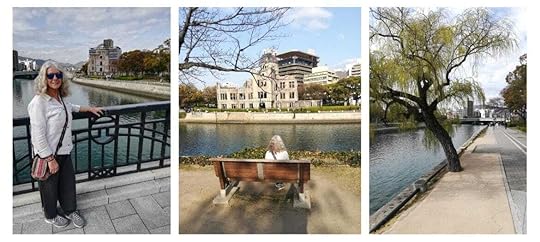 THE ATOMIC DOME
THE ATOMIC DOME
THE ATOMIC DOME: The Ganbaku Dome was one of the very few buildings to remain standing after the atomic bomb was dropped on Hiroshima on the morning of August 6th 1945.
Built in 1914 to an earthquake-proof design and with a copper dome roof, the building once served as a Commercial Exhibition Hall.

Designated a UNESCO Heritage Site in 1996 and now known as The Genbaku Dome (Peace Dome) the ruin is a striking reminder of the destructive power and the horror of atomic war. It now stands as an iconic anti-war symbol and a monument to peace.

HIROSHIMA NATIONAL PEACE MEMORIAL HALL
HIROSHIMA NATIONAL PEACE MEMORIAL HALL: This hall is a more recent addition to the Memorial Park as it was opened in 2002. Designed by Kenzo Tange and dedicated to the victims with names and portraits. The walkway through to the Remembrance Hall is atmospheric and depicts a haunting panoramic view of the city after the atomic blast.
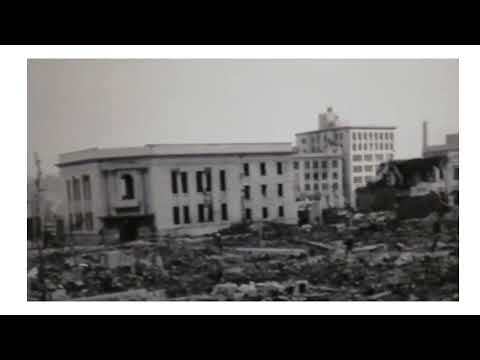
Inside the Memorial Hall: My video of the haunting panoramic view of the city after the atomic blast PEACE MEMORIAL PARK GROUNDS
PEACE MEMORIAL PARK GROUNDS: The Memorial Park is a vast 120,000 square meter area of grounds with foot paths, lawns, trees, statues, many different war memorials including the Atomic Dome, the National Memorial Hall, the Memorial Mound, the Cenotaph and the Flame of Peace. The Peace Clock chimes for perpetual peace at eight-fifteen every morning: the exact time the bomb was detonated on August 6th 1945.
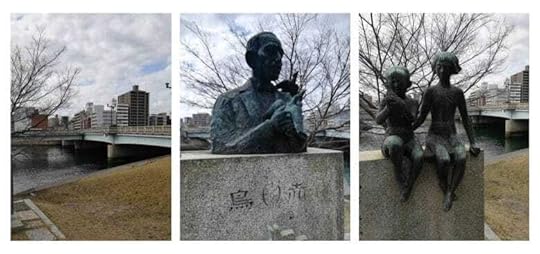
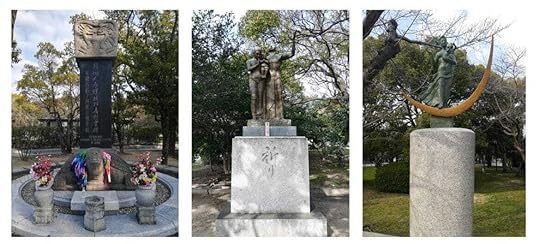 THE FLAME OF PEACE
THE FLAME OF PEACE
THE FLAME OF PEACE: The Flame of Peace is designed to symbolise a person’s arms pressed together at the wrists with hands pointing to the sky. I like to think the flame – sourced from the eternal flame temple on Miyajima Island – burns to represent our enduring hopes of a nuclear war free world.
But I’m told that the flame actually symbolizes the terrible thirst and need for water following the blast, that had the badly burned survivors running into the river and into the nearby lake in the city’s Shukkein Japanese Gardens. How absolutely horrific.
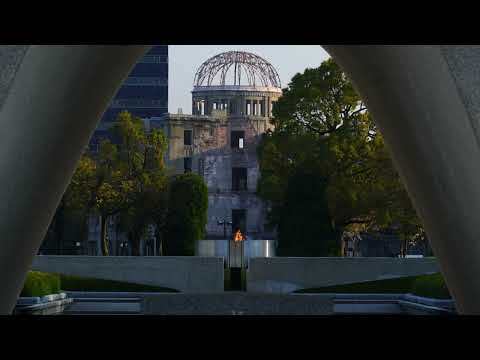
The Flame of Peace in Hiroshima THE MEMORIAL CENOTAPH
THE MEMORIAL CENOTAPH: The Cenotaph is a centrepiece in the Memorial Park and an arched design that holds the names of all those killed by the atomic bomb – over 300,000 souls. It frames the Flame of Peace and reflects onto the Pond of Peace.
A remembrance ceremony is held annually on August 6th at the Cenotaph and paper lanterns with prayers of peace are floated on the river. But everyday this Cenotaph serves to remind us of the terrible thing that happened here in Hiroshima.
 THE MEMORIAL MOUND
THE MEMORIAL MOUND
THE MEMORIAL MOUND: Close to the Children’s Monument and the Peace Bell, I found the sight of the Memorial Mound incredibly moving. It was a site of cremation after the bombing and, in a vault beneath the grassy mound, are the unclaimed and unidentified ashes of 70,000 people.
So many bodies were unidentifiable after the bomb and many reduced to ashes in the blast. But to this day, against all odds, work continues to try and identify the ashes of the unnamed and unclaimed and those names are published in local newspapers once a year.
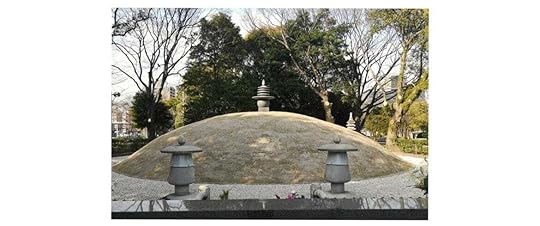 THE CHILDREN’S PEACE MONUMENT
THE CHILDREN’S PEACE MONUMENT
THE CHILDREN’S PEACE MONUMENT: A memorial to all the innocent children killed in the blast and then later from the effects of radiation poisoning.
The somewhat haunting image of a little girl standing on the top of the monument is Sadako Sasaki who died of leukaemia in 1955 as a result of acute radiation exposure. She was twelve years old.
The monument was erected in 1958 and is inscribed “This is our cry. This is our prayer. For building peace in this world.”
YOU MIGHT WONDER IF HIROSHIMA IS STILL RADIOACTIVE? The answer is no. The level of radioactivity in Hiroshima today is as low as any naturally occurring background radiation present elsewhere in the world.
 THE PEACE MEMORIAL MUSEUM
THE PEACE MEMORIAL MUSEUM
THE PEACE MEMORIAL MUSEUM: I sat down and recorded my thoughts and feelings onto video immediately after coming out from the Peace Memorial Museum. I was emotionally drained from re-living Hiroshima’s day of Hell and needed to say how I felt about the experience before being re-immersed into the present day.
I hope you will want to watch and listen to my heartfelt account of how I felt about it in the video below. There are no spoilers because it would be disrespectful to take photos or video inside the museum. But I do conclude that it is harrowing and that of you come to Hiroshima you really do have to experience it for yourself.

The museum is a harrowing and poignant place of atomic bomb victim memorabilia and art and horror stories being told to advocate in the strongest possible way for peace on earth. And today, The Hiroshima Peace Memorial Park IS a place of peace.
But, just so you are forewarned, the Memorial Museum IS a Museum of War.
 The Peace Memorial Museum
The Peace Memorial MuseumTO CONCLUDE:
The day I experienced The Hiroshima Peace Memorial Park in Hiroshima Japan, was a day that I’ll never forget. It was a day I felt so very sad and reflectively sombre because, of course, that’s exactly the way you’re meant to feel while you are there.
WHERE TO STAY IN HIROSHIMA JAPANWe used Booking Dotcom (affiliate link) to find and to book our various accomodation while in Japan and we very happy stayed three nights at J-Hoppers Hiroshima Guesthouse at a total cost of 17,000 Yen. That’s less than 100 GBP. The guesthouse was wonderful and I made a video of it to show you that it’s sometimes a good choice to stay in a budget accomodation to allow for more expenses in cities like, for example, Tokyo.
I hope you enjoy my video!
MY VIDEO – STAYING IN A HOSTEL IN HIROSHIMA JAPAN
Are you planning at trip to Japan?
Are you planning to visit Hiroshima?
Have you already been to Hiroshima?
Let me know?
Leave a comment below or message me.
I’ll be delighted to hear from you.

THE BACKPACKING HOUSEWIFE RECOMMENDS BOOKING DOTCOM
The post Exploring Hiroshima Peace Memorial Park appeared first on The Backpacking Housewife.
October 25, 2023
Midlife Travel: If Not Now, When?
Most days I receive wonderful messages from travellers in their 50’s and 60’s and from those already travelling the world in midlife and those lovely midlife wanderlusters who want to prioritise travel in their later lives, their empty nest years, and in retirement.
I absolutely love hearing from you all and it really makes my day!
The messages often contain travel questions or are simply to tell me that the sender has felt inspired by my travel posts. And, in this post, I’m featuring some of those messages and answering some of the questions I’ve been asked recently via my social media channels or directly into my inbox through my website Contact Me Page.
This is because I want to inspire you – but I also want to address the more emotive messages – from those of you whom are aspiring to travel more in your later years but now have unexpected travel angst.
Specifically, an angst about soon approaching the time of your lives when you might anticipate having more time and more resources and less obligations than ever before to facilitate travel, and then getting a big red stop light of doubt about it.
Like ‘Perhaps I’m too old to travel?’ How do I know I can afford to travel? Do I sell up or rent out? Should I sell up or downscale? What do I do with all the stuff I’ve accumulated: the personal treasures – the family photos – the kid’s baby memorabilia?
Or the ones that howl: “The family say they need me around to help out and babysit!
All at a time when you’ve been promising yourself that you’ll go off and see the world. When you’d really want to take that grown up gap year. Tick off your bucket list. Finally, visit friends and family abroad. Follow the sun. Live in sunshine and flip-flops and very few clothes. But then (as J says in his message below) ‘reality keeps putting me off’.
 LEAVING IT ALL BEHIND FOR THE ADVENTURE OF A LIFETIME
LEAVING IT ALL BEHIND FOR THE ADVENTURE OF A LIFETIMEAll valid points and questions and ones I want to answer because you are voicing perfectly reasonable and natural concerns to do with health, wealth, obligations and physical and mental wellbeing.
I’m certainly not dismissing any of these reasons not to travel in your 50’s and 60’s and beyond.
That suddenly aspects of travel – especially long-term travel – can suddenly feel selfish.
I want you to know that I understand and I want to offer you my support.
I do know it’s a big step to ‘leave it all behind for your adventure of a lifetime’ even if you are only doing it for a few weeks or several months or if you have a one year plan. I understand all the elements of concern because I’ve had them too.
I do know the ‘what if’s’ start to take hold and staying home in front of the TV seems a lot easier and much safer. But if you’ve always wanted to travel the big question is…. if not now, when?
Why wait until it’s too late?
IF NOT NOW, WHEN?
But if travel is your dream and you have always promised yourself a life of travel in your Third Age and if, like me, you’ve never thought a two-week holiday was long enough and the concept of travel means even more to you now than it did before and you’ve started to suspect that your life wasn’t meant to be lived in one place all of the time… then if not now, when?
Ten years ago, my backpacking husband and I sold our house, our business, our cars, our furniture and everything – once our sons had finished their education and left home to make their own way in the world – and we set off to travel around the world on the adventure of a lifetime. We weren’t doing it to escape life but rather for life not to escape us.
ZERO REGRETSWe have zero regrets. Over the past ten fabulous nomadic years, we’ve taken planes, trains, boats, buses and tuk-tuks, to make our way across sixty countries and all the continents and seas and oceans to end up wherever we happened to find ourselves next. We’ve lived in hotels and motels and hostels and homestays, city apartments and huts on beaches and to be honest, we don’t ever want our halcyon days of travelling to end. But they will. One day.
Unlike us, of course, you might not need or want to go to the extreme of selling all your belongings to fund your travels.
You might have other ways to do it. Perhaps you have an opportunity to work remotely now or take a work sabbatical or early retirement? Maybe your perspective on life has shifted due to the recent pandemic and you’re looking longingly at your travel bucket list and all you want to achieve sooner rather than later and before something else gets in the way of you heading off into the world on the adventure of a lifetime?
It’s true that as we age, we can face more health issues, and this can make travel more physically challenging and instead of taking comfort from all the reasons to travel – travel fear is replacing reasons why NOT to travel in your 50’s and 60’s!
So, I thought it was worth us addressing and examining a few of these concerns more closely to determine if they are valid.
Health and Travel ConcernsQuestion: I have health issues. What do I do if I lose my meds or need to replace my prescription medications in other countries?
Answer: Discuss this with your doctor. Can you get a repeat prescription to take on your travels? Can you take enough meds to cover your trip. I also suggest you find out the generic names of your medication so you can source it in other countries in an emergency. Do have medical travel insurance (affiliated link) in place before you travel. Don’t forget to read the policy carefully to make sure it covers your needs and don’t forget to declare all your existing medical conditions.
Question: What will I do if I get sick or I get hurt while I’m travelling?
Answer: Sickness or accidents can happen while at home or away. Travel insurance is essential when travelling outside your home country. For those with reduced mobility and mobility issues, I suggest you look for solutions as many methods of transport offer special assistance to those with mobility issues. By specifying your needs when making bookings and hotel reservations you may be able to overcome your mobility and transportation concerns.
Question: Where can I find travel Insurance for the over 50’s and over 60’s?
Answer: Although finding suitable travel insurance is more difficult as we age, you might find my detailed post on travel insurance for the over 50’s useful information. It’s also worth noting that other countries do have doctors and hospitals and as good or better and more affordable than in your own country. I have first hand experience of attending a doctor, a hospital, a pharmacy, and a dentist while abroad and receiving excellent care. I would always recommend you buy Travel Insurance.
Money and Financial Concerns
Question: How do I know if I can afford to travel?
Answer: Money is a difficult subject isn’t it? One person’s budget is someone else’s extravagance. I can only tell you that how much you need to travel the world depends on how savvy you can be booking your flights and transportation. It depends on where you stay as to how much you spend on accomodation. Transport and accommodation are the two costs we tightly control. We use Skyscanner (not an affiliated link) to plans and discover the best priced flights. It pays to be flexible and look at connected flights sometimes. But I would advise you – from my own experiences – to ALWAYS books directly with the airline you’ve identified rather than through a third party agent.
I use Booking Dotcom (affiliate link) for accommodation. We often privately rent a house or apartment if we’re staying longer that a week or two. We also housesit (free accomodation) on occasion too. We feel we can travel cheaply because we have no home associated costs and we often find food a lot more affordable abroad – especially in South East Asia.
So look at the kind of lifestyle you want to have while you travel. Is that first class travel and five-star hotels or budget airlines and homestays and hostels? I’m somewhere in the middle and like to mix things up depending on where I am in the world.
Look at your assets. What liquid access do you have to savings, investments and pensions? Look at your material assets and financial responsibilities. If you fall short of the cash reserves you feel you need to sustain the lifestyle you require then would you be prepared to sell or downsize? Some people will have to budget carefully but with careful planning you might be able to work out a feasible travel budget and a financial plan.
Join a travel forum and ask questions about the cost of living in the countries you want to visit. Travel forums are a great support for many aspects of midlife travel from finding flights to recommending accommodations and local travel advice and what to see. I’m a member of several Facebook Groups like ‘Nomads beyond 50 Network’ and ‘Full Time Travellers and Nomads’ and ‘Senior Nomads’ and others. I’m sure there’ll be a Facebook Travel Group that’s perfect for you!
Do look into how you’ll do your banking from abroad. It helps if you have online banking. Find out about bank cards and currency conversion and how to access your money abroad without having to pay exorbitant fees.
Family Obligations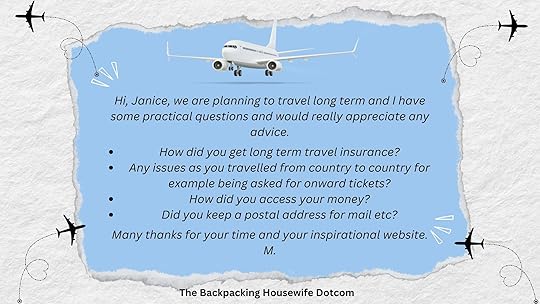
Question: I’m worried that my family will think I’m selfish to travel and leave them behind.
Answer: This is a biggie and one I’ve struggled with myself. I miss my family when I’m away from them and I feel guilty missing birthdays and special occasions. I resolve this by accepting rather than rejecting my emotions. I tell myself that my kids are now all in their 30’s and we did a great job of raising them to be successful and independent adults. But they have their own lives – busy lives – and even if we lived nearby we wouldn’t see them all the time.
I make an effort to stay in touch with friends and I chat with my family every day through social media. We have family message groups and we always check in – post photos – tell jokes – and generally keep our relationships close and tight.
Family and friends have on many occasions visited us and taken their holidays in places in the world where we’ve settled for a while. We often pop back to visit them too, of course, and on a couple of occasions we’ve done so on the very next available flight when we’ve been needed. The world is perhaps smaller than you think?
But if you do have family responsibilities you want to keep up, like caring for grandchildren and elderly parents or you have family pets and livestock that restrict your ability to travel for longer periods, then I would suggest short haul travel breaks might be possible under these circumstances.
The, if and when the mainstay of family obligations have eased off, you might once again consider leaving family behind for a while in order to travel more extensively in your 50’s and 60’s.
Comfort Zone
Question: The world often looks scary when I watch the TV news. How do I know I’ll be safe?
Answer: Travel fears can increase with age, making it more challenging to venture to new places. I feel the news and media coverage is often to blame for scaremongering. Not in all cases of course because there are war zones and there are places declared dangerous and under travel advisories. But generally, and in my personal experience, as long as you choose your travel arrangements with care and act abroad as you would in your own country, then personal danger is usually low and most people you’ll meet are good people. I wrote a post called Scary Travel Horror Stories and How To Avoid Them that you might find both interesting and entertaining!
Solo Travel or Travel CompanionQuestion: Should I travel alone?
Answer: Mostly I travel as a couple with my backpacking husband – I have on occasion travelled alone and also with a girlfriend – but I do understand that finding compatible travel companions can be more challenging as one gets older.
My solo travelling friends all tell me that at first the thought of travelling alone was frightening – but until you actually do it you’ll never know – and soon you’re likely to start enjoying your own company and being on your own schedule without compromise. Meeting new people gets easier along the way and strangers are just friends you haven’t met yet.
If you are a novice traveller – solo or with a partner/companion – then I would advise you take a short manageable trip to ‘try out’ travel to start out. Then extend that to several weeks of travel and then perhaps a few months. Travel groups are also a good idea if you want to immerse yourself into the world with a support group. Be bold not old.
Cultural ShockQuestion: Some countries seem appealingly exotic but I’m worried I’ll feel out of my depth once I get there.
Answer: Traveling to destinations with significantly different cultures may perhaps feel more intimidating in later years. If you’ve spent a lifetime being shaped by your own culture, then culture shock while experiencing other countries is normal.
Culture shock and can be down to different customs, types of dress, religions, perhaps how women are treated or how animals are valued. It can be especially difficult for those with dietary restrictions or food preferences to adapt. I wrote a post about my own feelings of culture shock – in reverse – because my experience was of coming back into the developed world!
Do your homework and travel planning and find out about the country you want to visit to prepare yourself. Have a chat with someone who has been there before and ask questions. Travel forums on social media are a great source of information and wisdom.
Embracing cultural difference is important. Try to learn a little of the language. Even a few phrases like hello and thank you. Be prepared to open your mind. Travel is an education.
Am I too old to travel?Question: I’ve waited until my retirement to travel. I’m wondering if I’ve left it too late?
Answer: There is a saying often expressed to those of us who travel later in life – “you are never too old to travel”.
Well, I’m afraid I don’t agree. Because there will come a day when you are too old to travel. When you’re too frail. Too stiff and too tired. When perhaps you’re not entirely of sound mind anymore and when the personal risks outweigh the benefits.
As a disclaimer, I am not a medical professional, so if you are seriously worried about being too old or too unfit to travel then you should see your doctor or medical physician and ask them if you are medically fit to travel.
If your doctor tells you that you’re medically fit to travel then take that as a green light.
If he tells you you’re unfit to travel then you will have to reconsider your travel plans or at least tame them.
BUT if you DO have your health in your 50’s and 60’s and in your later years and you have suitable amount of disposable cash to spend on travel and you also have your freedom – then why not travel now – before it IS too late!?
Midlife Travel: If Not Now, When?
Are you looking to travel more in your midlife and beyond?
Do you have a travel question you’d like me to answer?
Leave a comment below or send me a message.
I’d love to hear from you!

The post Midlife Travel: If Not Now, When? appeared first on The Backpacking Housewife.
October 21, 2023
Shinkansen: Japan’s Bullet Train
I’ve experienced travelling on high-speed trains between cities before in Asia. Notably the KTX Korea Train Express in South Korea and the THSR Taiwan High Speed Rail. But Japan’s Shinkansen bullet train really is in a class of its own.
I was excited to experience high-speed train travel in Japan by taking the Shinkansen Tokyo bound train from Fukuoka to Hiroshima on my recent two-week four-city Japan trip.
The ‘fastest bullet train’ reputation alone had me in anticipation of an exhilarating journey and I wasn’t disappointed.
For me, riding the Japanese bullet train was more like travelling on an aircraft than a train, as we accelerated smoothly out of Hakata Station in Fukuoka gaining speed and travelling out of the city and through the Japanese countryside.
Tip: To expand video first tap on the video and then on the square in the bottom right corner.
The incredible speeds we reached only really felt apparent to me on the bends in the track when you could actually feel slight G-forces on your body. I’ve certainly not experienced that feeling on a train before.
I stared out the window as we zoomed past the towns and houses and rice fields between Fukuoka and Hiroshima and towards Tokyo.
A fantastic experience.
These trains are known for punctuality, safety, speed and efficiency. Passengers can enjoy comfort and amenities, spacious seating, clean facilities, and onboard dining services, as they travel across Japan.
An absolutely must-do experience when visiting and travelling in Japan.
The Shinkansen network connects major cities such as Tokyo, Osaka, Kyoto, Hiroshima, and Fukuoka. But you should know, if you’re planning on a train ride through Japan and travelling between a few different Japanese cities on your trip, then it might work out more cost effective for you to travel the trains using the JR Pass.
JAPANESE RAIL PASS – THE JR PASSThe Japanese Rail Pass is ONLY available to tourists and allows for discounted travel within Japan between cities BUT you have to apply online for your JR Pass before you arrive in Japan. Same is true of the Suica Card for travel WITHIN cities on trains, buses, ferries etc. I’ve written a detailed post on the JR Pass and the Suica Card – how you get them – and the differences between the two HERE.
 SHINKANSEN MEANING
SHINKANSEN MEANINGShinkansen (新幹線) in Japanese means ‘new trunk line’ or ‘new main line’, but this word is used to describe not only the high-speed trains but railway lines and the rail network, too.
THE FIRST AND FASTEST BULLET TRAINThe Japan Bullet Train revolutionized train travel in Japan and set the standard for high-speed rail systems worldwide. Not only was the Shinkansen the very first high-speed rail network in the world (debuting in 1964) but, as engineers continued to push the boundaries of high-speed rail travel and bullet train technology, it is now the fastest train on Earth.
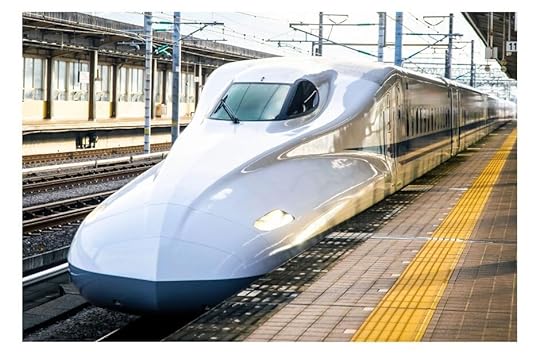 HOW FAST IS THE JAPANESE BULLET TRAIN
HOW FAST IS THE JAPANESE BULLET TRAINTravelling at hundreds of km per hour might sound scary, but despite carrying millions of passengers each year, the Shinkansen is also famous for its excellent safety record down to its advanced technology and meticulous safety measures.
The speed of Japanese Bullet Trains, or Shinkansen, can vary depending on the specific line and model of the train. The Tōhoku Shinkansen (Tokyo to Sendai) line trains can reach maximum speeds of around 320 kilometres per hour (200 miles per hour).
5 JAPANESE BULLET TRAIN FACTS The concept of the Shinkansen goes back to the 1950s when the first line, the Tōkaidō Shinkansen, opened in 1964 in time for the Tokyo Olympics. This marked the debut of the world’s first high-speed rail system.The Shinkansen utilizes advanced technology to ensure a smooth, safe, and comfortable ride. This includes advanced signalling systems, electromagnetic suspension, and aerodynamic designs to reduce noise and wind resistance. The Shinkansen train uses superconducting maglev (short for magnetic levitation) to achieve these incredible speeds. As the train leaves the station it’s rolling on wheels. But as it speeds up, the wheels retract, and the power of magnets allows the vehicle to hover four inches above the ground.Shinkansen trains are punctual to the minute. Delays of even a minute or two are considered noteworthy and the schedule is so precise it has a reputation for being one of the world’s most punctual train systems.The Shinkansen is seen as an environmentally friendly mode of transportation compared to other options like domestic flights or cars, as it produces fewer carbon emissions per passenger-kilometre.
The concept of the Shinkansen goes back to the 1950s when the first line, the Tōkaidō Shinkansen, opened in 1964 in time for the Tokyo Olympics. This marked the debut of the world’s first high-speed rail system.The Shinkansen utilizes advanced technology to ensure a smooth, safe, and comfortable ride. This includes advanced signalling systems, electromagnetic suspension, and aerodynamic designs to reduce noise and wind resistance. The Shinkansen train uses superconducting maglev (short for magnetic levitation) to achieve these incredible speeds. As the train leaves the station it’s rolling on wheels. But as it speeds up, the wheels retract, and the power of magnets allows the vehicle to hover four inches above the ground.Shinkansen trains are punctual to the minute. Delays of even a minute or two are considered noteworthy and the schedule is so precise it has a reputation for being one of the world’s most punctual train systems.The Shinkansen is seen as an environmentally friendly mode of transportation compared to other options like domestic flights or cars, as it produces fewer carbon emissions per passenger-kilometre.To Conclude: The Japan Bullet Train is not only an essential part of the country’s transportation system but also a symbol of technological innovation and efficiency. It has inspired high-speed rail projects in many countries and continues to be a source of pride for Japan. I can only imagine, coming from the UK, how amazing it would be to one day have this kind of fast and efficient rail network in the West!
Are you planning a trip to Japan?
Which cities in Japan are on your travel wish list?
Will you be travelling by Shinkansen Bullet Train?
Let me know! Leave a comment or send me a message?
I’d love to hear from you.
THE BACKPACKING HOUSEWIFE RECOMMENDS TRAVEL INSURANCE
THE BACKPACKING HOUSEWIFE USES AND RECOMMENDS BOOKING DOTCOM
The post Shinkansen: Japan’s Bullet Train appeared first on The Backpacking Housewife.
October 19, 2023
Fukuoka – Gateway To Japan
A trip to Japan during ‘sakura’ the cherry blossom season has long been on my travel bucket list!
I was so very excited indeed to be visiting Japan earlier this year as part of our six-month trip around Asia.
Our Japanese itinerary included a two-week four-city sight-seeing adventure taking in Fukuoka, Hiroshima, Tokyo and Osaka.
So join me now at the very start our Japanese journey and travel with me in Fukuoka!
OUR TWO-WEEK JAPANESE ITINERARY
The Backpacking Husband and I travelled to Fukuoka Japan from South Korea. It is possible to take the Busan to Fukuoka ferry from Busan Port in South Korea to Hakata Port in Fukuoka, which takes just under four hours, but as the short flight was affordable and convenient, we decided to fly.
Our journey to Japan began by us taking the KTX Train (Korean Bullet Train) south from Seoul and Daegu to Busan’s (Gimhae) Airport from where we took the one-hour (140 miles) flight over to Fukuoka Japan. (PUS-FUK).
SUICA CARDS AND JR PASSES I’ve written a more detailed post on Suica Card/JR Pass HERE
I’ve written a more detailed post on Suica Card/JR Pass HERE
We landed at Fukuoka airport and after completing immigration went to collect our WELCOME SUICA CARDS at the KLOOK Collection Centre (not an affiliate link) in the airport arrivals hall.
The Welcome Suica Card is an IC ‘tappable’ and easily ‘top up-able’ tourist transportation payment card accepted on Japanese trains and buses, subways, trams, and ferries.
I absolutely recommend you organise your Suica Cards and JR Pass if you need one too ahead of your visit to Japan because, as a tourist, it can’t be done once you’ve arrived. I’ve written a more detailed post on how you get a Suica Card and/or a JR Pass – how they work and the differences between the two – HERE.
FUKUOKA AND HAKATA: A FUSION OF TWO CITIESFukuoka was our gateway into Japan and is one of Japan’s major cities. It’s located on the northern shore of the island of Kyushu and facing the Korea Strait. The city has a rich history that dates back to ancient times which accounts for its dual identity.
To explain, Fukuoka Japan is actually a fusion of two cities: the port city of Hakata and the former castle town of Fukuoka.
The two are separated by the Naka River but were merged into one city now called Fukuoka but Hakata remains one of Fukuoka’s central districts.
Fukuoka is known for its mild climate and is considered one of the most liveable cities in Japan. I was looking forward to exploring a city that’s just as well known for its modern malls and it is for its ancient history.
We do enjoy walking and so used Google Maps as a guide to finding the best walking routes around the city and to the places of interest that I’d already identified for our itinerary.
As we had only planned for three nights in Fukuoka, before travelling on to Hiroshima, we were determined not to waste a single minute. I had already done my research on the best place to stay and the places we wanted to visit and experience in Fukuoka during our trip.
This included shrines and temples and gardens and a walk along the picturesque canal promenade to Canal City Hakata shopping mall, where we wanted to see the famed light and music show, and then through the old streets to Kawabata Craft Market.
We wanted to experience the famous Hakata food because Fukuoka is also known as one of Japan’s best food cities.
We also wanted to explore the sophisticated bar scene and we’d promised ourselves a sandwich from a Lawson’s Store – simply because we’d watched an episode of Anthony Bourdain’s in which he proclaimed he was ‘in love’ with a Lawson’s egg sandwich as it was the best sandwich he’d ever eaten. Wow. We had to try it!
There really is so much to see and to do in Fukuoka that I had to accept that on this trip, we were only going to be able to scratch the surface of the sights and experiences, of this beautiful Japanese city.
WHERE TO STAY IN FUKUOKA JAPANWhen we arrived from the airport to the main Hakata Station, we then took the metro train to Nakasu Kawabata Station. Our hotel was a short walk away and it was easy to find. I’ve included two location maps below to show you the area.
We stayed at Hotel Hakata Nakasu Inn and we booked using (aff) Booking Dotcom.
We chose to stay in the Hakata district of Fukuoka which turned out to be the perfect place for us because of its central location in Hakata. The hotel was walking distance to everything we wanted to see and do in Hakata and from the nearest metro train station (1350 feet away) for convenient transport links.
 Our hotel location marked with the red circle in Nakasu DistrictFukuoka – Gateway To Japan
OUR FUKUOKA JAPAN TRAVEL ITINERARY
Our hotel location marked with the red circle in Nakasu DistrictFukuoka – Gateway To Japan
OUR FUKUOKA JAPAN TRAVEL ITINERARY
TABLE OF CONTENTS
OUR FUKUOKA JAPAN TRAVEL INTINERARYNANZOIN TEMPLE – THE RECLINING BUDDHAHOW TO GET TO NANZOIN TEMPLETHE MELODY BRIDGE AT NANZOINNANZOIN TEMPLE TRADITIONAL JAPANESE GARDENSHIGHBALL BARS IN FUKUOKAHIGHBALL BAR NAKASU 1923 – HIGHBALL RECIPEFUKUOKA FOOD SCENECANAL CITY HAKATALAWSON’S EGG SANDWICHES!NANZOIN TEMPLE – THE RECLINING BUDDHAI really enjoy visiting temples all around Asia and I was particularly excited to visit the Nanzoin Temple. This is a Shingon Buddhist temple in Sasaguri, Fukuoka, Japan, is the first temple on the most well-known pilgrimage in Japan – The Sasaguri Pilgrimage of eight-eight temples – which concludes at the top Mount Wakasugi.
But to be clear – I’m not a pilgrim – I just really wanted to see THE WORLD’S LARGEST RECLINING BUDDHA BRONZE STATUE. No, I’m not kidding, it really is in Fukuoka. For perspective, at 41 metres long, that makes the statue of Shakyamuni as he reclines, around the same size as New York’s Statue of Liberty if it were horizontal!
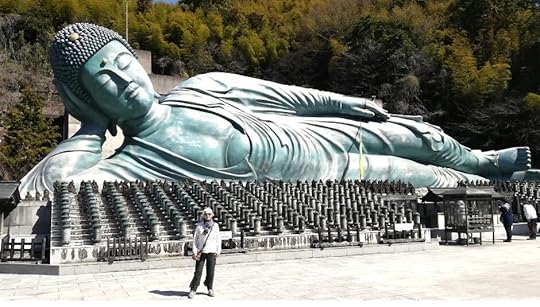 The Backpacking Housewife and the World’s Largest Bronze Reclining Buddha
The Backpacking Housewife and the World’s Largest Bronze Reclining Buddha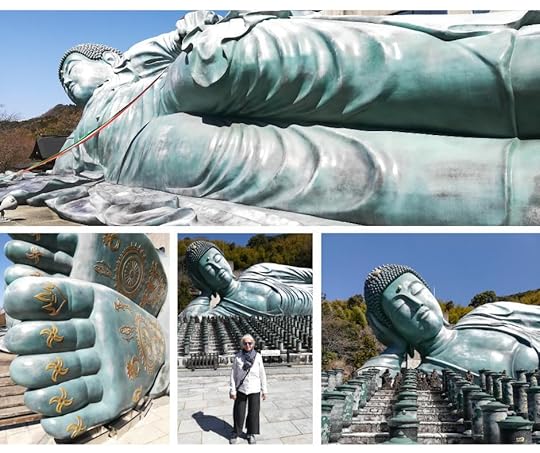 The Backpacking Housewife at The Reclining Buddha FukuokaHOW TO GET TO NANZOIN TEMPLE
The Backpacking Housewife at The Reclining Buddha FukuokaHOW TO GET TO NANZOIN TEMPLEThe Nanzoin temple is easy to get to by direct train from Hakata Station and the journey time to Kido Nanzoin-Mae station is less than 30 minutes. The Nanzoin Temple is surrounded by countryside and mountains and its traditional Japanese Gardens are a wonderfully peaceful respite from the city.
After arriving at the small Kido Nanzoin-Mae station you make your way over the Japanese Temple Bridge known as The Melody Bridge, crossing the stream and heading towards the main (not busy) road. Turn right and take a short walk uphill towards the Nanzoin Temple entrance.
THE MELODY BRIDGE AT NANZOINOn the Melody Bridge you can play a tune if you wish as on both sides of the bridge’s supporting structure encases a xylophone and tapping the bars creates a song called Hometown or Furusato in Japanese!
Having and paid your entrance fee to see the Reclining Buddha you can make your way past statues and shrines and through the Seven Lucky Gods tunnel to the plateau of the Reclining Buddha.
NANZOIN TEMPLE TRADITIONAL JAPANESE GARDENSAfter viewing and marvelling at the World’s Largest Reclining Bronze Buddha, and having said a prayer at his feet for good luck, we made our way up many stone steps and along winding pathways. We walked under many ‘torii’ gates that represent the boundaries between the spiritual world and the mundane world where humans live and spent at least a couple of hours making our way around the traditional Japanese Gardens at Nanzoin.
Filled with mischievous looking statues wearing knitted hats, they really are magical!
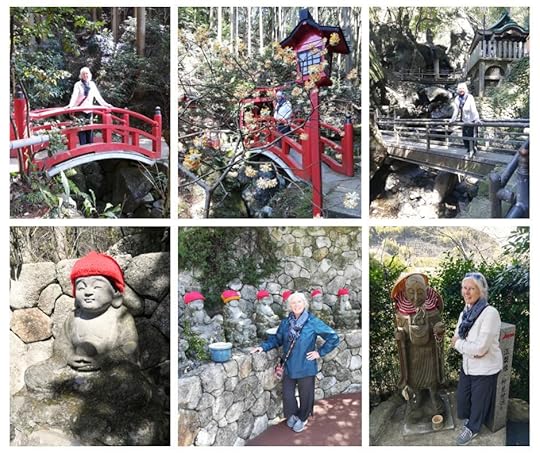 HIGHBALL BARS IN FUKUOKA
HIGHBALL BARS IN FUKUOKAI might have expected the Japanese national drink called Sake – an alcoholic beverage made from fermented rice – to be the main drink of the bar scene in Hakata but it’s whisky instead. Bourbon, actually.
In Japan, certainly in Hakata anyway, the drink that everyone enjoys and is commonly served in all the izakayas (Japanese bars and drinking restaurants) is the HIGHBALL!
The Highball is a strong alcoholic beverage (usually whisky) served in a large glass of ice and topped with a carbonated soda or sparkling water. All the bars we stopped off at were serving highballs exclusively and favouring American Bourbon whisky.
As great fans of drinking bourbon, the Backpacking Husband and I were delighted to stop off at some of the small street bars in Hakata and then at The HighBall Bar Nakasu 1923 – a traditional but sophisticated bar – where we paid around 1500 Yen ($10) each as a cover charge to sit at the bar but were served lots of delicious nibbles as we quaffed our bourbon highballs!
HIGHBALL BAR NAKASU 1923 – HIGHBALL RECIPE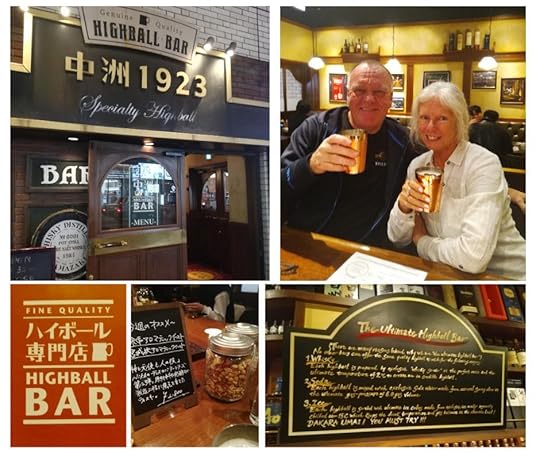
 FUKUOKA FOOD SCENE
FUKUOKA FOOD SCENEYATAI STREET FOOD: Hakata is famous for its yatai or street-food stalls that specialise in fresh local dishes – often seafood – and which pop up each evening along the streets flanking the canal. Yatai are typically small temporarily erected tents with a central kitchen area and a narrow counter with seating for around eight diners at a time.
Eating at a Yatai is popular with both locals and tourists and, in such closely confined dining spots, it is a great way to meet people. Some of the most well-known yatai hosts choose to notify their customers of their latest location around town using social media.
We had a fabulous experience of eating in a Yatai when we were on our way back to our hotel in Hakata’s Nakasu area. The street’s pavements had been empty earlier in the evening but were now lined with tents and people eating and drinking inside them.
We spotted one with two seats on a bench and went inside. We were warmly welcomed immediately by Mama-San the host of the Yatai who was cooking seafood over hot charcoals inside the tent and her six assorted guests.
Two of the guests, to our left, where smartly dressed Japanese businessmen who were clearly quite inebriated. They absolutely insisted on buying us drinks.
Beer and… highballs, of course. Oh dear!
The other four guest on the bench seat, to our right, consisted of a trendy looking young woman and a young man – whom I was quite fascinated with as he was dressed in such elaborate clothing that to me he looked like a magician. The other two were another couple of well-dressed drunk businessmen – one Japanese and one South Korean – who absolutely insisted we tried their barbecued shrimp that Mama-San had just plated up. We had such a great time in that Yatai!
HAKATA RAMEN: Hakata Ramen is a type of ramen with a rich pork-bone broth and noodles that has really put Fukuoka on the culinary map – not only in Japan but throughout the world. Hakata is the home of the original and now famous Ichiran Ramen Restaurant.
Eating Hakata Ramen at The Ichiran Ramen Restaurant was absolutely a priority ‘to-do’ on my Fukuoka itinerary.
But I knew that you have to be patient and be willing to wait in line on the street outside the restaurant for a table as it is always so popular!
Our experience of eating at the original Ichiran Restaurant in Hakata did not disappoint.
From ordering using the strange wooden menu machines to sitting in the individual booths and being served the personally cooked ramen noodle dish it was all fantastic!
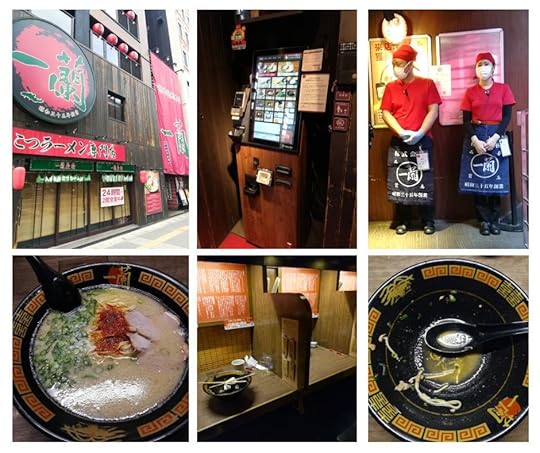 CANAL CITY HAKATA
CANAL CITY HAKATAWe went to Canal City shopping mall ‘The City within a City’ in the evening because we wanted to experience the Dancing Fountains of Light and Music Show after dark.
This show is being hailed as a “Canal Aqua Panorama – Japan’s largest comprehensive entertainment show – with 3D projection mapping over 2,500 inches of walls and glass and a water screen together with concert hall-like acoustics and lighting effects.”
The 5 minute show goes on every 30 minutes from 10am to 10pm.
All this in a shopping mall? We simply had to see it! Watch my video!
LAWSON’S EGG SANDWICHES!It might seem a little crazy, but the backpacking husband and I are big fans of the Late Anthony Bourdain and we’ve watched all his travel shows. In one of his No Reservations episodes he praises the Japanese convenience store Lawson’s egg sandwich and their spicy chicken nuggets. Of the egg salad sandwich, he says:
“At Lawson’s, you can dig into their unnaturally fluffy, insanely delicious, incongruously addictive egg salad sandwiches. I love them. Layer after layer after layer of awesome.”
Lawson is a chain of convenience stores in Japan and they promote themselves as “A lifestyle supermarket for people who are particular about food.” Well, I had to find out what the fuss was about and if those egg sandwiches and chicken nuggets really were as delicious as Saint Anthony had claimed!
Japan has just been declared the World’s #1 Travel Destination!
Are you planning a trip to Japan?
What cities and sights would you like to see in Japan?
Has this Guide To Fukuoka been helpful to you?
I’d love to hear from you.
Leave a comment in the box below!
Keep popping back because I have SO MANY more articles yet to post!

THE BACKPACKING HOUSEWIFE RECOMMENDS TRAVEL INSURANCE
THE BACKPACKING HOUSEWIFE USES AND RECOMMENDS BOOKING DOTCOM
The post Fukuoka – Gateway To Japan appeared first on The Backpacking Housewife.
















